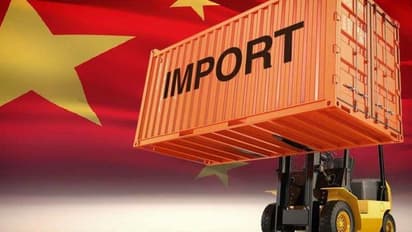Why India Inc still relies heavily on Chinese imports

Synopsis
Recent research conducted by an Indian government-aided university says certain areas of the Indian economy rely heavily on imports from China that are deemed indispensable. Girish Linganna reports
A recent report has raised concerns about the viability of India's attempt to reduce its dependence on China. The report indicates that Chinese goods are not only crucial to various sectors but are also the preferred choice of Indian manufacturers in many instances.
Cutting ties with China in view of this may not be practical, the report noted.
According to the report compiled by the Indian Institute of Foreign Trade (IIFT), a government-aided university in New Delhi, the increasing import of Chinese goods is not only contributing to the growth of India's manufacturing sector and its exports in significant areas as pharmaceuticals, inorganic chemicals and iron and steel but has also led to a corresponding rise in output in those industries, except iron and steel.
The report emphasizes the importance of Chinese goods in industries where they were either the only option or, more significantly, the most affordable one. The report suggests that Prime Minister Narendra Modi's push for India's self-sufficiency be reassessed.
According to a paper authored by Professor Sunitha Raju of the IIFT, self-reliance in India is possible only if the country's indigenous manufacturing sector succeeds in producing high-tech goods. If this is achieved, increasing imports will no longer be a thorn in India's flesh, as it will result in a corresponding increase in exports.
Professor Raju recommends that India reduce trade barriers and provide an impetus to imports for strengthening the country’s indigenous production capabilities. This would boost the growth of the manufacturing sector and create greater employment opportunities.
India's Commerce Ministry is yet to respond on the matter.
Since the 2020 conflict between Indian and Chinese troops at the border, Delhi has been striving to separate India's economy from China's. India has implemented measures to limit Chinese investments, prohibited Chinese companies from operating in such critical areas as power and railways, and removed several Chinese-origin mobile applications, including the widely used TikTok.
Despite these strictures, bilateral trade has touched the sky. In 2022, bilateral trade reached a record US$135.98 billion, according to Chinese customs data. Chinese imports make up over $100 billion of India's total trade -- a cause of concern for Delhi. In January, the Modi government called together 18 key ministries to brainstorm ways to reduce the number of imports coming in from China.
According to the research, out of 32 product sub-categories imported from China, it was found that, in almost 33% of the cases, it offered the lowest prices. However, for the remaining 70%, there were other less expensive options; despite that, Chinese products ranked high in choice.
"There's a misconception that Chinese imports are preferred only because they are cheaper," says Professor Raju. The quality of Chinese goods varies depending on the price that buyers are willing to pay. "We found many domestic buyers who said they preferred the quality of products from China to products made elsewhere." This leads to more market intricacies because China is the only source for 16 products, which gives local manufacturers limited options.
According to Naresh Gupta, head of the India-China Chamber of Commerce, there are various segments of India's economy that rely on imports from China, ranging from automobiles to renewable energy. Gupta says such industries as pharmaceuticals rely so heavily on imported products that they would cease to operate in their absence. He states that China provides more than 60% of the inputs necessary for the pharmaceutical industry. Any delay in imports could, thus, result in manufacturing coming to a grinding halt.
Experts point out that the situation in the telecommunications industry is quite similar. According to an anonymous senior member of India’s telecom sector, the industry relies heavily on imports from China. According to another telecom industry expert, even though phones are being produced in India, the majority of the components used in manufacturing are sourced from China. Consequently, the phones are essentially being assembled in India rather than being manufactured from scratch.
According to a recent study, a majority of the products India imports from China fall under the category of medium- to low-end technology indicating that India’s manufacturing capabilities are not up to par, says Professor Raju.
To stem the flow of imports from China, it is necessary to either find another country from which to import or to possess the ability to manufacture the goods domestically. Without either of these options, the situation becomes difficult to manage.
According to both Gupta and Professor Raju, the Modi administration needs to shift its focus from the ‘Self-Reliant India’ campaign to boosting a more export-oriented manufacturing sector. Gupta says the government needs to establish favourable circumstances for industries to function smoothly, which includes facilitating the rapid acquisition of land and providing affordable electricity.
Professor Raju suggests there is a need to review the Modi government’s policies, pointing out that India should increase its investment in R&D and innovations, instead of solely concentrating on the domestic market.
The government should also focus on involving micro-, small- and medium-sized enterprises in local manufacturing instead of solely relying on large foreign companies to invest in the country. This would require building the capacity of local businesses to produce goods domestically.
The author of this article is a Defence and Aerospace analyst
Stay updated with all the latest Business News, including market trends, Share Market News, stock updates, taxation, IPOs, banking, finance, real estate, savings, and investments. Track daily Gold Price changes, updates on DA Hike, and the latest developments on the 8th Pay Commission. Get in-depth analysis, expert opinions, and real-time updates to make informed financial decisions. Download the Asianet News Official App from the Android Play Store and iPhone App Store to stay ahead in business.